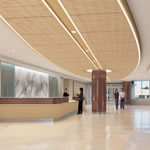When the Fairfax County Department of Public Works and Environmental Services (DPWES) adopted the Fairfax County Sustainable Design Policy in 2008 to formalize its commitment to sustainable development, it set the stage for the county’s $48.5 million Mid-County Human Services Center, one of seven LEED-targeting projects under construction.
Expected to be complete in fall 2014, the facility is pursuing LEED Silver certification, which will add to the county’s 15 additional buildings that have already received certifications from the USGBC. The building replaces an old health center and consolidates behavioral and alcohol and drug service programs under one roof. “The centrally located facility will offer community-based services and supports to prevent crises and help people with behavioral health challenges integrate successfully into the community,” says Katayoon Shaya, project coordinator of building design and construction for Fairfax County DPWES. “The building itself is designed to integrate successfully and beautifully with its physical surroundings.”
Although the design was first and foremost consumer-focused, Fairfax County’s use of evidence-based design strategies fit hand-in-hand with sustainable design practices. “From the onset of planning and design, the team has placed a very high priority and focus on the green features across the design, construction, operations, and maintenance of the facility,” Shaya says.
65%
Reduction in parking garage energy costs for Fairfax County facility via lighting controls
Both structures—a five-story, 200,000-square-foot building and a four-story, 230,000-square-foot parking garage—were designed with long-span, post-tensioned, cast-in-place-concrete structural frames. The building’s skin is a glazed curtainwall with ribbon windows that have insulated and low-E coated glazing units, and it has an aluminum panel system along with the architectural precast concrete panels.
“The base of the building is wrapped in natural and regionally quarried granite, which also continues into the main lobby,” says Yoko Yarita-Gallishaw, project manager with Noritake Associates, the architect for the project, “to visually anchor the building in its surrounding site design, providing a visual and material continuum from the hardscape to the building and from the outside in.”
The central plant HVAC system uses chilled and hot water, reducing the building’s overall dependence on compressors with refrigerant circuits. The facility’s lighting control system uses photocell sensors to minimize the electrical lighting levels during the day, and occupancy sensors with dimmers were installed. The majority of the offices and meeting spaces have energy-efficient T5 fluorescent lamps, and decorative lighting in the waiting areas and lobbies contain color-changing LEDs to simulate seasonal colors, which studies have shown can lift patients’ moods.
The 712-space parking structure is exclusively lit with LED fixtures and uses a lighting control system that provides a 65 percent reduction in energy costs compared to other lighting systems. When it rains, storm water is collected and taken to a regional storm-water management pond directly adjacent to the project site. Shaya says that the rain gardens were placed to collect runoff across from two of the three main entrances, making them an educational feature as well as a sustainable one.

